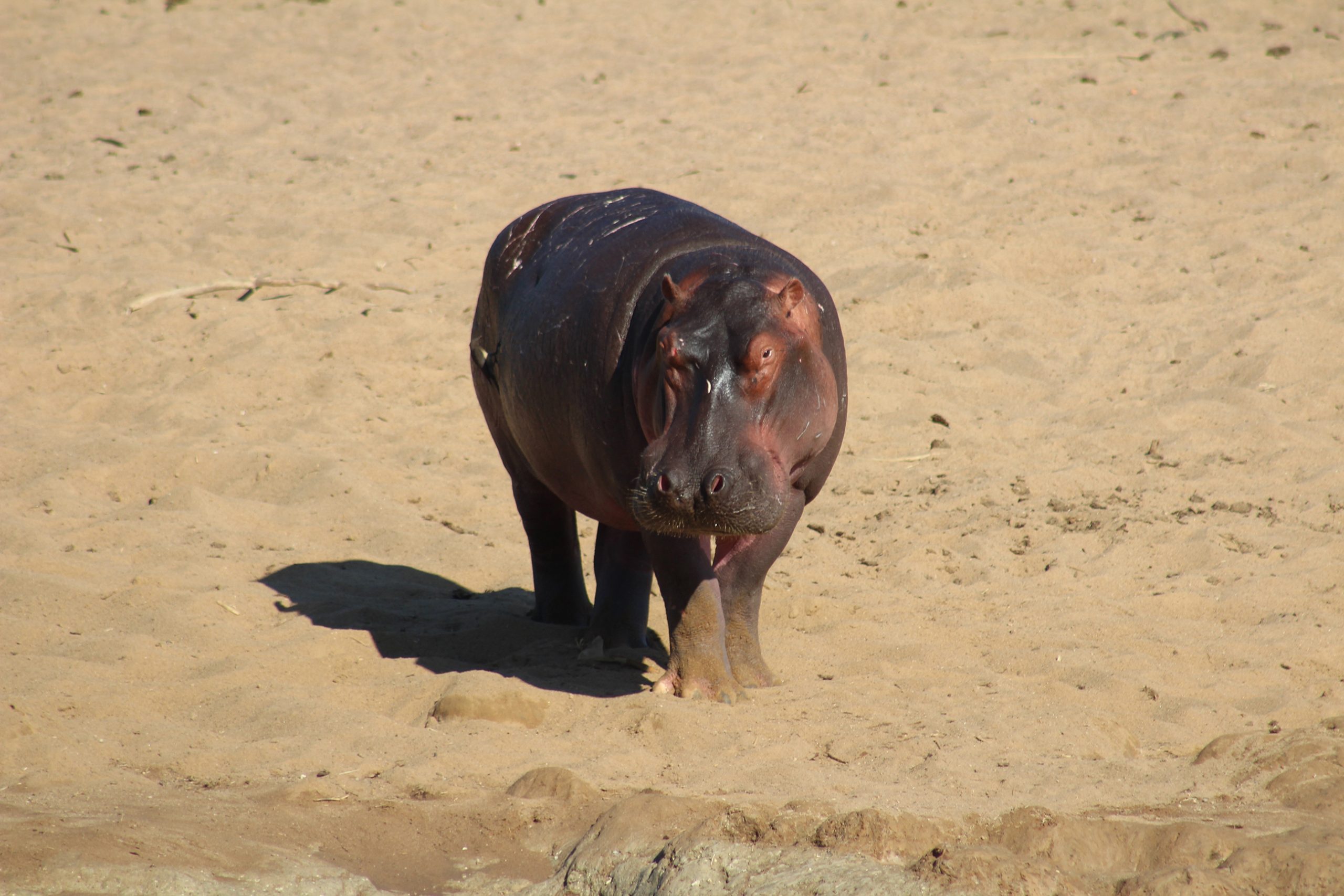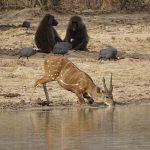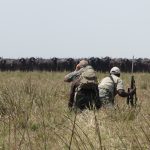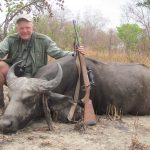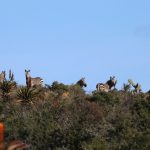This member of the “Dangerous Seven” is a worthy adversary, especially if you catch him on land.
On a hunt in the northeastern Central African Republic (CAR) in 1994, every few hours the terminalia forest would be jolted by a rifle shot. Poachers had invaded in organized gangs, drying meat and taking it home to Sudan by camel and donkey caravan. There were no “authorities,” so the outfitter had established an uneasy truce; poachers and legal hunters avoided each other; there were no problems while I was there. The French Foreign Legion would eventually clean things up (repeatedly, over decades), but much damage was done to wildlife.
By this time, the once-numerous elephants were long gone. In this new wave of meat poaching, they first worked their way down the rivers, going after hippos, which are an easy target for poachers. Although huge, a hippo’s skull is fragile. A hippo in its water sanctuary is easily potted by a poacher on the bank, who puts an AK47 bullet in the “target” forehead indentation between and just above the eyes. If the bullet is properly placed, the hippo sinks straight down. Within two hours the carcass will bloat and rise to the surface. It is roped and floated to the shore, and a ton of meat is easily recovered.
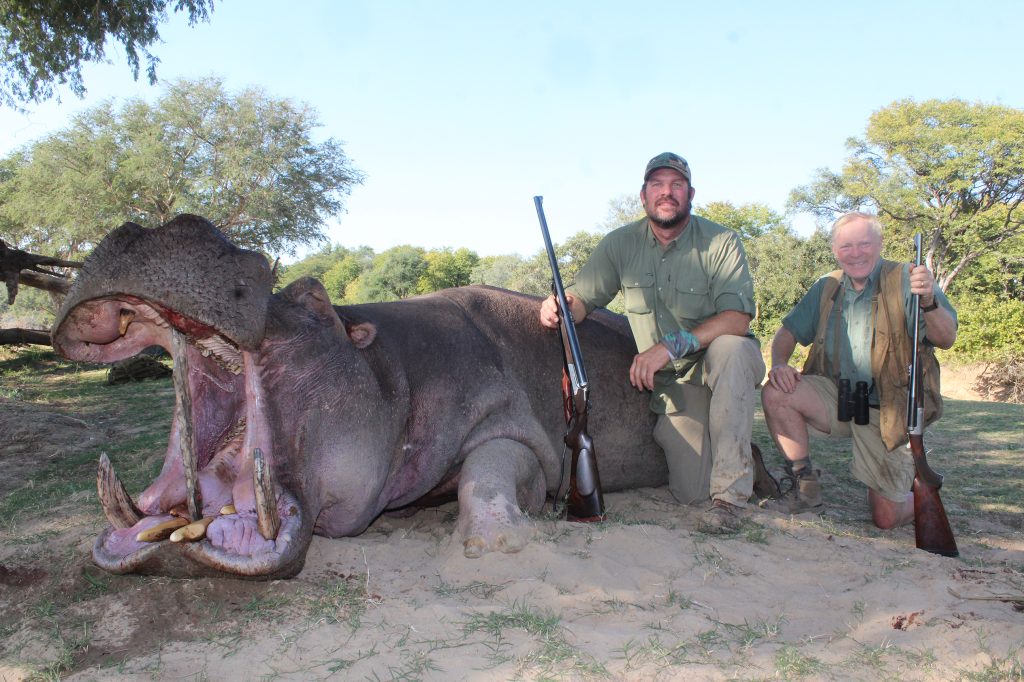
Not so long ago, hippos were endemic along most of Africa’s waterways. With a burgeoning human population, and because hippos are so easily poached, they have nearly vanished from many rivers and lakes. The long-term effects remain to be seen. By eating underwater plants and creating paths, hippos perform an important function in keeping waterways open and flowing.
Fortunately, hippos remain common in many areas, especially in countries that have managed their wildlife well. So, hippos can still be seen daily along river systems such as Chobe, Limpopo, Luangwa, Rufiji, Ugalla, and Zambezi and, in some areas, there are significant concentrations. In my younger days, hippos were often “on license” and available. The major tusks of a big bull hippo, much of the length concealed in the jaw, have always been great prizes, but we didn’t really consider the hippo a “game animal” as such.
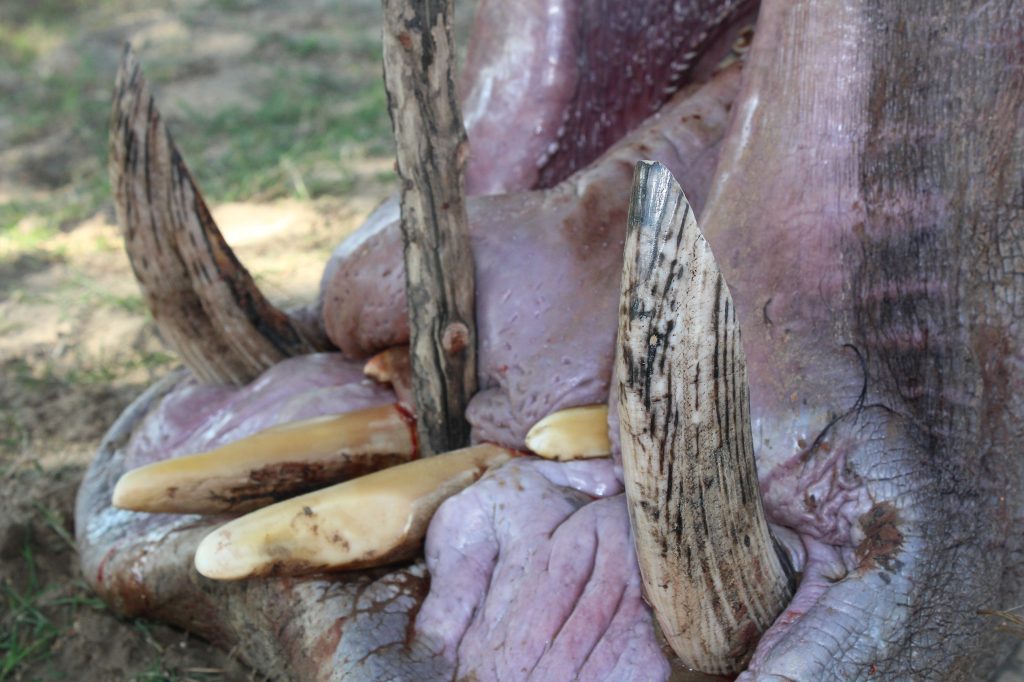
Back in the days when a lion was commonly on license, the first step in lion hunting was to secure a hippo as quickly as possible. This remains true today, except that a lion safari is now a costly and specialized undertaking. Also, in areas where hippos are still hunted, quotas are usually small and carefully managed. This has greatly elevated the hippo’s status, with hunting fees usually exceeding costs for hunting buffalo.
In the early days, hunters often spoke of Africa’s “Big Four” of buffalo, lion, rhino, and elephant, excluding the leopard not because it wasn’t dangerous, but based on size. In my time, we added the leopard and called it the “Big Five.” Although the second-largest terrestrial creature (after the elephant), the hippopotamus was never part of either grouping. Today, hunters often speak of Africa’s “Dangerous Seven,” adding hippo and Nile crocodile. This is a good thing, because it has added desirability (and thus value!) to both species.
Without question, the hippo is a large, potentially dangerous, and often ill-tempered brute. It is often said that the hippo is responsible for killing more Africans than any of the rest, sometimes couched as “more than all the rest combined.” I don’t believe this is true; I’ll give that questionable kudo to the crocodile, which still takes people on a near-daily basis along some crocodile-infested rivers.
Even so, the hippo is a real hazard to rural Africans because of its habits. Hippos typically spend most of their days resting in water, but they are grazing animals requiring huge amounts of forage. At night they graze on land, often traveling miles in search of good grass. Early in the morning they return to their water sanctuary, placing them on a collision course with humans, who habitually go to fetch water and wash in the morning.
At night I’ve heard hippos placidly grazing outside my tent in a dozen African camps. No danger, but you wouldn’t go outside and try to pet one. And, you don’t want to get in a hippo’s way if it wants to go somewhere! They charge readily, all chomping jaws and razor-sharp teeth. No such thing as a minor bite from a hippo. Some hippos have attitudes, and take grave exception to small boats intruding in their tranquil waters. The dugout canoe or mokororemains Africa’s primary water craft for fishing and transport; attacks by hippo are not uncommon. My own closest call from an African Big Nasty was a hippo attack on a mokoro. Usually, however, you just need to give them a wide berth.
I totally support the concept of the hippo as a game animal, and as a member of the Dangerous Seven. However, hunting a hippo is usually not a similar experience to stalking buffalo or closing with elephant. It would be, if you could reliably track up or glass and stalk your hippo. In fact, it could be all the excitement you want, and more! On land, in daylight, a hippo is out of its element, and will often charge. If the brain shot is unavailable, or fails, the hippo is a giant bullet sponge, stoppable only with heavy rifles.
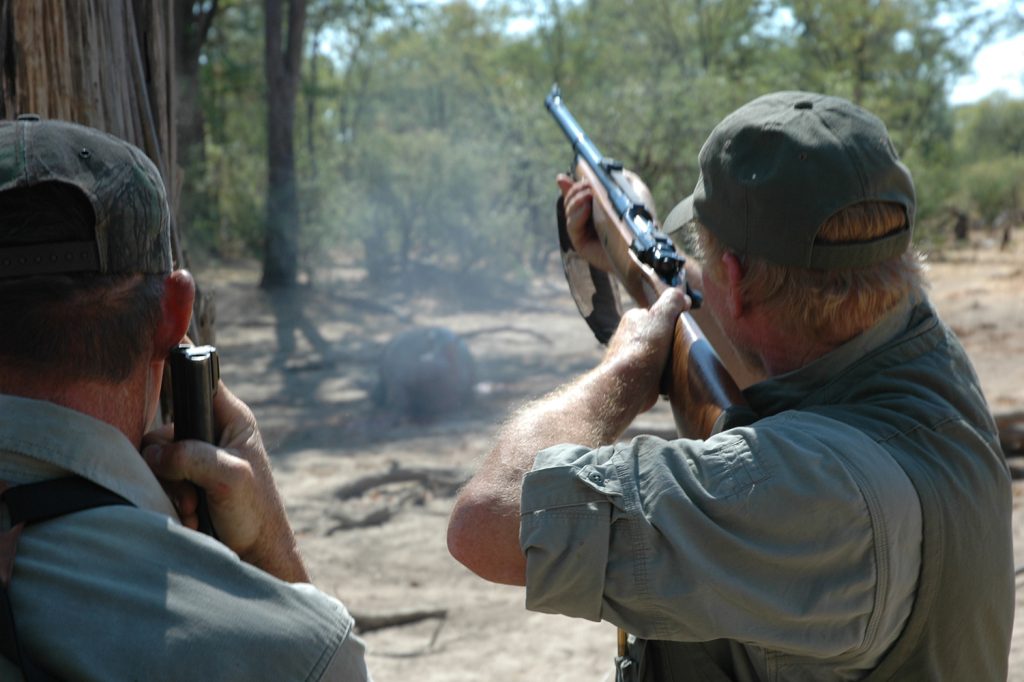
Problem is, in most areas it’s uncommon to catch hippos on land in daylight, with the odds ranging from unlikely to nearly impossible. It does happen. Tanzania’s Selous Reserve is famous as a place to find hippos sleeping in the bush far from water. In 1988, looking for buffalo tracks with Paddy Curtis, we found fresh hippo spoor far from known water. We tracked it up and found the bull sleeping in thick bush. As we approached, it heard us, woke up, and immediately charged. Plenty exciting!
I have no idea why this is commonplace there; it must occur in other areas, but only the Selous is well-known for “hippos in the bush.” In the Zambezi Valley, we occasionally encountered hippos far from the river; not common, but it happens. Often, and in many areas, a lone hippo—usually a younger bull—will take possession of a small waterhole, remaining there so long as there’s enough water to submerge.
Almost anywhere, individuals, or an entire hippo pod, will occasionally climb out onto a bank where a stalk is possible. In my experience, this seems most common on a cloudy day. Whenever you catch hippos on land, you can seize the moment, but it’s not an event you can count on. Most commonly, if you want a hippo—or if you urgently need a hippo quarter for a lion or crocodile bait—you have little choice but to catch them near shore in their sanctuary; be patient and take the brain shot.
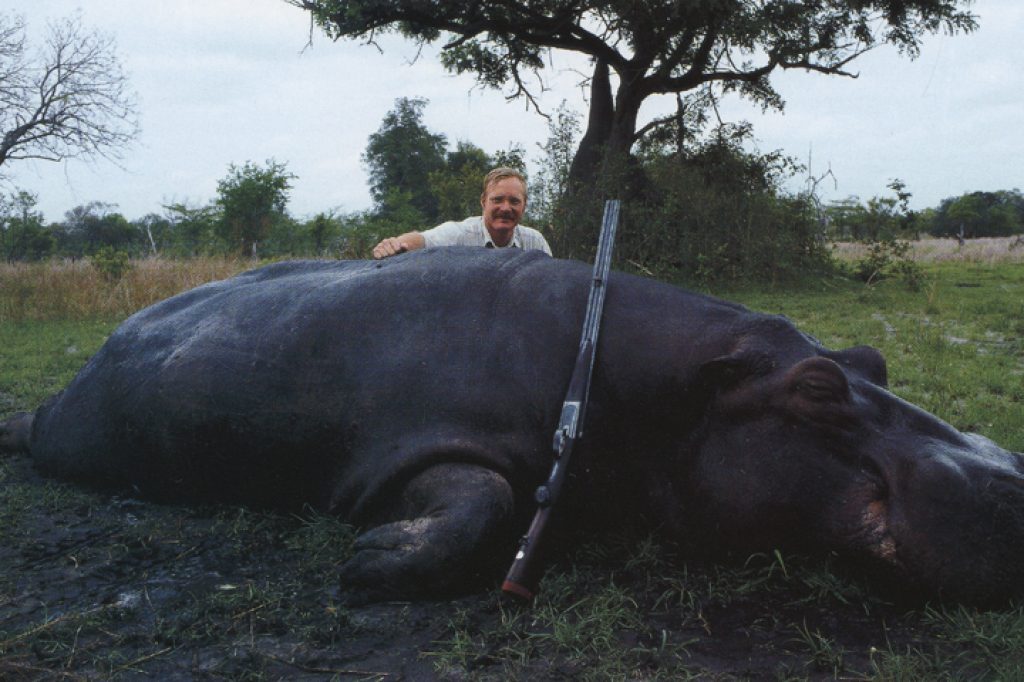
I am not in any way against this; absent a bit of luck, that’s the way it’s usually done. Also, if you want a big bull hippo with large tusks, taking them in water isn’t just the most selective option; it’s almost the only way to be certain. Hippos are difficult to judge, and a lone hippo is almost impossible. In a pod, resting in sanctuary, it takes patience and time, sometimes hours.
You look first for sheer size. Then, as the heads pop up to breathe, you look for prominent bumps on the upper lip on both sides of the nostrils. These are actually pockets sheathing the sharp ends of the major tusks. Bigger the bumps, bigger the tusks. Eventually, if you’re patient enough, the hippos will shift around and partially surface, exposing prominent and identifiable scars. Male hippos fight ferociously. With more patience and luck, a hippo will open its mouth to yawn and call, and you can actually see the tusks.
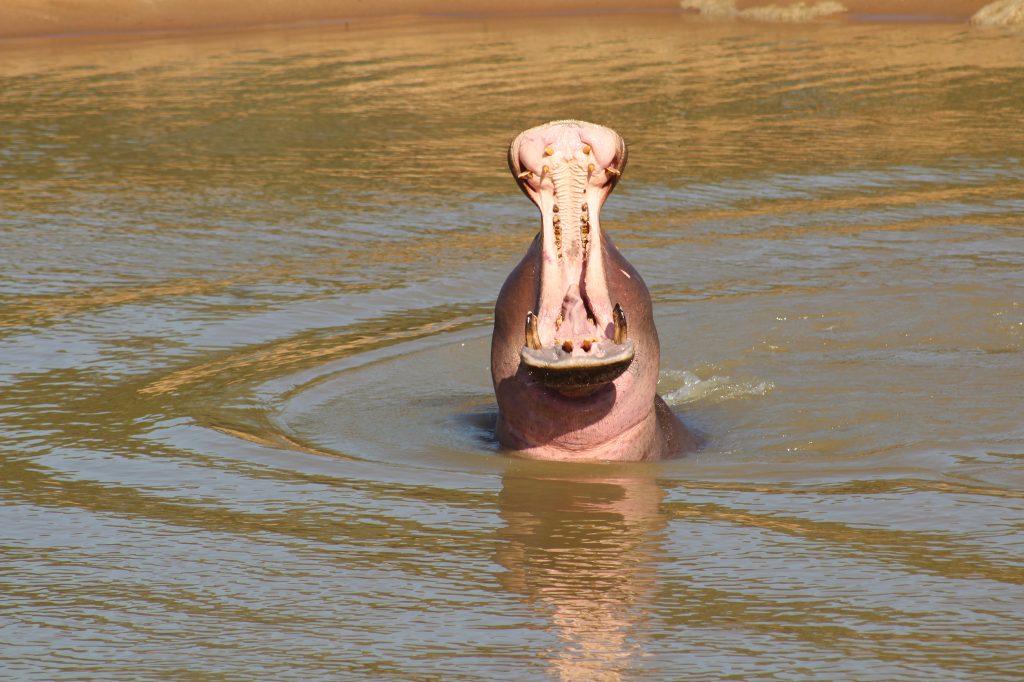
Now, with a bull identified, more patience and a steady shooting position is required. Eventually, the hippo will surface enough to offer a proper brain shot: Frontally, between and just above the eyes, in that weird target-like indentation. From the side, base of ear. The shot is tricky and must be precise. I’m not denigrating the practice; typically, this is the way it’s done, and there is often no option. But, let’s be clear: The hippo is in the water; the shooter is dry. There is no danger.
If the brain shot is executed correctly, the hippo sinks with barely a ripple. Two hours later it rises. You have plenty of meat for bait, for the camp, and for a couple of villages. Except that somebody has to go into the murky, crocodile-infested water to secure a line, which requires raw courage mixed with craziness! Water or land, it’s easy to flub the brain shot. Then things happen fast. Be prepared to shoot again instantly. Look for the shoulder, and don’t hesitate!

